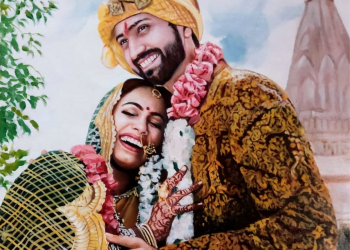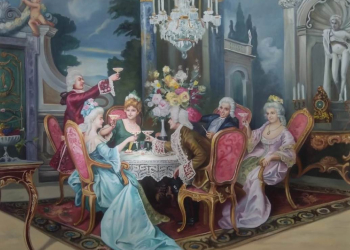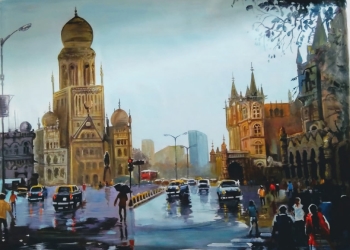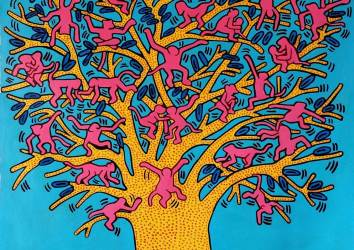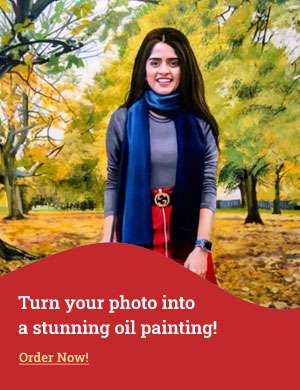A poet with a brush, Rabindranath Tagore redefined Indian art with his bold, symbolic paintings, blending primitivism, modernism, and global influence. Discover how his unique painting style, shaped by personal grief, spiritual depth, and a rejection of academic norms, opened new paths in Indian modernism. From haunting figures to abstract forms, Tagore’s artworks, exhibited across Europe and US, continue to inspire and challenge how we view both art and identity.
Rabindranath Tagore (1861–1941), a name synonymous with Bengali literature, poetry, philosophy, and music, stands as a towering figure of the Indian Renaissance and the first non-European to receive the Nobel Prize in Literature. While his literary achievements have garnered global acclaim, his foray into the realm of visual art during the later years of his life represents a compelling and distinctive contribution to the landscape of modern Indian art. This essay aims to undertake a deeply researched and critical exploration of Rabindranath Tagore's artwork, analyzing its evolution, recurring themes, unique techniques born from his lack of formal training, and the underlying philosophical principles that guided his creative vision. His relatively late yet prolific entry into the world of painting, around the age of sixty-three in 1924, represents a radical departure from colonial academic realism and revivalist traditionalism. Tagore’s art embodied a modernist vision that paralleled and enriched his literary and philosophical work, contributing uniquely to the Indian avant-garde.
Historical and Biographical Context
Born into the culturally rich milieu of the Bengal Renaissance in Calcutta, Rabindranath Tagore’s early life within the prominent Tagore family of Jorasanko was steeped in intellectual and artistic pursuits. His educational experiences were unconventional, as he eschewed formal schooling, yet he absorbed a vast array of cultural influences, from Indian traditions to Western thought. Tagore’s shift towards visual art in his sixties was not a sudden occurrence but a gradual evolution stemming from doodles and erasures on his manuscripts, particularly from the mid-1920s onwards.
Tagore’s striking turn toward modernism was first recognized in 1924 by the Argentinian writer and intellectual Victoria Ocampo. While nursing a convalescing Tagore during his stay at her villa in Buenos Aires, she discovered a notebook filled with spontaneous doodles formed from crossed-out texts, early examples of his experimental visual art. Captivated by his unconventional creativity, Ocampo reached out to Georges-Henri Rivière, the Curator of the Trocadéro Museum in Paris. Ocampo persuaded a known advocate of ‘primitive’ art, Rivière, to organize an exhibition of Tagore’s work.
Order Your Portrait Painting from Photo today!
Reflecting on the changing visual culture of his youth, Rabindranath Tagore once remarked, ‘In my childhood, when Ravi Varma’s age arrived in Bengal, reproductions of European paintings on the walls were promptly replaced with oleographs of his works.’ Yet, as an artist, Tagore charted a path distinct from both European academic realism and the dominant Indian revivalist aesthetics of his time. Unlike Amrita Sher-Gil’s grounded realism and empathetic portrayals of Indian peasants, Tagore’s primitivist paintings were playful, even ludic, expressions of inner subjectivity rather than external reality. They also diverged from Sunayani Devi’s unique primitive style, which drew deeply from Bengal folk traditions like Kalighat Pat painting and indigenous dolls, and from Abanindranath Tagore’s romantic miniatures, known for their lyrical and mystical tone. In contrast, Rabindranath’s art embraced childlike spontaneity and instinctual form, locating him within a more introspective, psychologically charged mode of modernism.
His lack of formal training, childlike simplifications, and ‘stream of consciousness’ approach resonated deeply with the avant-garde, who were increasingly drawn to the aesthetics of primitive and child art. As Partha Mitter writes in The Triumph of Modernism: India's Artists and the Avant-Garde 1922–1947, 'The primitivism espoused by the Bauhaus Expressionists resonated with him, and later seems to have flowered into his expressionist paintings.'
Rabindranath Tagore's painting style - Artistic Themes, Motifs, and Techniques
Tagore’s artistic repertoire, created between 1928 and 1941, encompasses over two thousand paintings with recurring themes and motifs. Dreamlike figures, often with masked faces, appear frequently, conveying a range of intense emotions from melancholy to menace. Otherworldly beings, along with real and imagined animals, also populate his canvases, reflecting his rich imagination and a blend of the familiar and the fantastical.
Rabindranath Tagore's lack of formal training profoundly shaped his artistic techniques and stylistic characteristics as a largely self-taught artist. The absence of academic instruction allowed him to approach painting with a remarkable degree of spontaneity. Relying on his intuition and innate sense of rhythm, which was deeply ingrained from his extensive work in poetry and music. His creative process was often immediate and unplanned, flowing directly from his mind onto the paper.
Tagore experimented with a variety of materials, including pen ink (often black ink being dominant), waterproof ink, crayons, watercolors, and pastels. He was known to use unconventional tools such as rags, swabs of cotton, and even his own fingers to apply paint. His stylistic features are marked by bold and often rhythmic lines, simplified forms, and a unique sense of composition. He frequently employed a limited color palette, often with aberrant uses of color beyond traditional representation. His landscapes often exhibit a geometrical flatness, sometimes broken by attempts at perspectival depth. This freedom from academic constraints allowed Tagore to develop a highly individual and expressive visual language. He viewed accidents and spontaneity as integral to creation, embracing the element of "play" in art. One that resonated with the spirit of modernism despite his lack of formal training.
Rabindranath Tagore’s modernism drew from two distinct yet complementary sources: the decorative elegance of Art Nouveau and Jugendstil graphics, and the raw, expressive power of ‘primitive’ masks and totemic forms. His early experiments with visual form began as playful interventions in graphic design, notably seen in an altered text page around 1905. These explorations evolved in the 1920s into the calligraphic ‘erasures’ found on the manuscript pages, where swirling Art Nouveau motifs—volutes, tendrils, entwined creepers, and sinuous arabesques—merged with traditional Indian decorative styles.
There is an uncanny kinship between Tagore and the Jugendstil artist Adolf Hölzel: one a poet and the other a painter, yet both deeply engaged with the integration of text into visual art. This convergence was not merely stylistic but also conceptual, rooted in a shared understanding of rhythm. Hölzel spoke of the "inner rhythm of the soul" and regarded the line as a vital form of energy, encouraging artists to explore "linear expressive movement." Tagore, too, found in rhythm a central principle; his paintings, marked by sparse use of color and simplified forms, were animated by a flowing, calligraphic line born out of his earlier textual experiments. As a poet, composer, and choreographer of dance-dramas, Tagore was sensitive to rhythm, once describing the universe itself as “an endless rhythm of lines and colours.” In 1930, he declared his ultimate goal to be the pursuit of ‘the rhythmic significance of form’ rather than the depiction of facts or ideas. Rhythm, for Tagore, became the very backbone of his visual expression.
What propelled Rabindranath Tagore’s visual art beyond the realm of the decorative into a more radical modernist idiom was his engagement with the dark, symbolic landscape of the psyche. Particularly through his encounter with the ritual aesthetics of non-Western cultures. His discovery of Native American, Oceanic, and African ritual masks, totemic animals, facial scarification, and body tattoos marked a turning point. These elements offered a visual language that was raw, primal, and emotionally charged—vastly different from the ornamental fluidity of Art Nouveau.
Evidence of this early interest can be found as far back as 1905, in a page of jottings within the text of Kheya, where Tagore sketched motifs inspired by the Haida and Tlingit art of the Pacific Northwest. The engagement matured over the following decades, culminating in the haunting image of a reptilian creature in the 1923 Rakta Karabi manuscript. It's grotesque intensity drawing directly from the totemic, mythic forms of tribal art. Such imagery marked a deeper exploration of the unconscious, the mystical, and the primal. A psychological turn that aligned Tagore with the expressionist undercurrents of global modernism.
One of the most enigmatic motifs in Rabindranath Tagore’s visual art is the primitive mask. Traditionally, an identity concealment device, the mask in Tagore’s hands becomes a tool for probing the inner self, what it hides, and what it reveals.
Tagore’s recurring image of the face-as-mask, cropped, featureless, impassive, suggests a psychological interiority. These haunting, stylized portraits are often linked to the memory of Kadambari Devi, his sister-in-law, whose suicide deeply affected him. The mask thus becomes a site of mourning, ambiguity, and emotional repression.
In this, Tagore aligns with Western modernists like Edvard Munch and Paul Klee. Like Munch, the artist behind the Scream, who used the mask to express inner anguish and alienation, Tagore turned to abstraction and distortion to explore psychic depth. And like Klee, he fused poetry, rhythm, and spontaneous mark-making, drawing on both primitive and childlike forms to access the subconscious.
From around 1928, Tagore took a more formalist stance, refusing to explain his art. At the India Society in London in 1930, he remarked, 'People often ask me about the meaning of my pictures. I remain silent even as they are. It is for them to express and not to explain.'
Tagore’s art stands apart from the moral clarity of academic realism and the overt symbolism of the Bengal School. Through masks, monsters, and dreamlike figures, he expressed the fractured, ambiguous consciousness at the heart of modernism—quietly radical, deeply personal, and profoundly ahead of its time.
Handmade Art Reproductions & Landscape Paintings
International Exhibitions and the Reception of Tagore’s Art
Tagore’s foray into the international art scene gained momentum with his 1930 European exhibition tour, beginning in Paris at the Gallerie Pigalle in May. This exhibition of around 400 works traveled to London, Berlin, Dresden, Munich, Sweden, Denmark, and Moscow, garnering considerable attention and generally positive responses from Western critics and artists who often noted his originality and affinities with modern movements like Expressionism and Surrealism.
Except in Great Britain. The English critics cold-shouldered his exhibition, offended at the poet’s denunciation of the inhuman Jallianwala Bagh massacre in 1919, where under the direction of Brigadier General Dyer, the British imperial army shot and killed over 1000 unarmed people, including women and children, who were attending a political meeting at Jallianwala Bagh, in Amritsar.
However, his exhibitions across the Atlantic in the United States in late 1930 received a more muted reception.
Tagore’s paintings were exhibited across North America, with shows in Toronto, New York, and Philadelphia. For the New York exhibition, Ananda Coomaraswamy, renowned art historian and curator of the Asian Collection at the Museum of Fine Arts, Boston, offered high praise, framing Tagore’s work within the lineage of modern primitive art. He admired the spontaneity and innocence of the paintings, noting their distance from Tagore’s more self-conscious literary persona. In his words: 'The artist, like a child, invents his own technique as he goes along; nothing has been allowed to interfere with zest. The means are always adequate to the end in view: this is not ‘Art’ with a capital A, on the one hand, nor, on the other, a mere pathological self-expression; not art intended to improve our minds, nor to provide for the artist himself an ‘escape’; but without ulterior motives, truly innocent, like the creation of a universe.'
Not all Western responses to Tagore’s art were uncritically admiring. Among the dissenting voices was his former friend, the French novelist Romain Rolland. Disturbed by what he saw as a turn inward, Rolland expressed dismay that Tagore would indulge a private artistic passion while India was in political turmoil. 'One wonders about his egoism,' he wrote in his diary, 'when all the Indian leaders are in prison and India suffers its heroic passion.' His comment highlights the tension between those who saw it as a bold personal and aesthetic evolution and those who expected him to remain engaged in the heroic Indian political struggle for Independence.
While celebrated in literary circles, his paintings did not create the same stir. In India, recognition during his lifetime was limited. Posthumously, Tagore’s art has been reevaluated, with increasing recognition in India, culminating in his work being declared a National Art Treasure. His paintings are now understood as a vital part of Indian modernism.
Rabindranath Tagore's Famous Paintings
Rabindranath Tagore, Untitled after Primitive Art,1932
This untitled gouache on paper is marked by bold outlines and a restrained yet vivid palette. The elongated, totemic figure, with its black contours, almond-shaped eyes, and internal luminescence, evokes indigenous motifs and European modernism, filtered through a personal, expressionist style.

Untitled after primitive art 1932, Painting by Rabindranath Tagore
The warm orange-yellow contrasts with a visceral red ground, enhancing the emotional impact. Minimal features and black-striped motifs hint at tribal forms, yet remain fully integrated into Tagore’s modernist vision. Far from academic realism, this piece underscores his inventive approach to form, color, and symbolic resonance.
Head Study
This untitled head study by Rabindranath Tagore is a striking example of his late expressionist portraiture. Likely executed in ink or a similar fluid medium, it reflects his departure from realism toward a more emotionally charged, structurally simplified style.
 Head study painting by Rabindranath Tagore (Image Source: Wikimedia.org)
Head study painting by Rabindranath Tagore (Image Source: Wikimedia.org)
The face emerges from the pale background in bold, gestural strokes, with strong contrasts of light and shadow giving it sculptural weight. Angular features, an elongated nose, a sharp jawline, and flattened planes, impart a sense of monumentality. The eyes, rendered as dark slits, evoke introspection and psychological depth, while the loosely sketched hair adds dynamic texture.
Typical of his late work, this study shows Tagore’s shift toward a subjective visual language. Influenced by broader expressionist trends yet rooted in his philosophical vision, the piece reveals a powerful sense of presence and inner life. It affirms Tagore’s role as a literary figure, and a pioneering voice in Indian modern art.
Dancing Girl
This untitled work, aka the Dancing Girl, attributed to Rabindranath Tagore, exemplifies his late exploration of abstract figuration and expressive movement. Likely done in gouache on paper, it abandons realism in favor of rhythm, gesture, and emotional resonance.
 Untitled Dancing Girl Painting by Rabindranath Tagore (Image Source: Wikimedia.org)
Untitled Dancing Girl Painting by Rabindranath Tagore (Image Source: Wikimedia.org)
The figure, suggested rather than defined, emerges from swirling reds, oranges, and yellows, with sweeping lines and layered colors conveying motion and energy. Form is fluid and dynamic, prioritizing the sensation of dance over anatomical precision. The composition evokes rhythm and theatricality through its bold contrasts and gestural marks.
Dancing Girl exemplifies his synthesis of indigenous aesthetics with modernist expression, creating a visual language rooted in intuition, rhythm, and inner experience.
Rabindranath Tagore, Untitled, 1930s
This untitled work by Rabindranath Tagore, exhibited in Germany in 1930, marks his turn toward symbolic and abstract figuration during a period of international recognition. Likely executed in ink, gouache, or crayon, it depicts a field of small, mask-like faces in blues and blacks floating against a pale ground.
 Untitled 1930s Painting by Rabindranath Tagore
Untitled 1930s Painting by Rabindranath Tagore
The repeated, stylized faces lack individuality, suggesting a collective presence or a meditation on the shared human psyche. Their uniformity and subtle variation hint at deeper psychological or philosophical concerns, such as identity, multiplicity, or alienation.
Dark tonalities and loose, gestural brushwork create a moody, layered composition. The contrast between the faces and background intensifies the image's tension and depth.
This work reflects Tagore’s shift towards abstraction and introspection in the late 1920s and early 1930s. Its exhibition in Germany positions it within a broader dialogue with European modernism, highlighting Tagore’s unique fusion of Indian sensibilities with global avant-garde currents.
Cowering Nude Woman
One of Tagore’s most unsettling paintings, Untitled (Cowering Nude Woman) 1934, executed in colored ink and wash on paper, depicts a naked, androgynous figure crouched beneath looming, clothed figures, perhaps judges or tormentors. The scene evokes a psychological tension absent from his literary work, suggesting a power dynamic of control and submission, sexuality and vulnerability.
 Untitled Cowering Nude Woman 1934, Painting by Rabindranath Tagore
Untitled Cowering Nude Woman 1934, Painting by Rabindranath Tagore
The figure is distorted, limbs elongated, posture hunched. Tagore abandons anatomical realism in favor of expressive form. The washes of blue, green, and ochre blend into one another, heightening the sense of fragility and emotional weight. The lack of facial detail universalizes the subject’s pain, inviting the viewer to feel rather than analyze.
This work exemplifies Tagore’s late-career shift toward a modernist idiom, rooted in psychological and emotional resonance. It shows his growing willingness to engage with discomfort, ambiguity, and interiority, positioning him as a visual artist deeply attuned to the darker currents of human experience.
Woman's face
This untitled portrait by Rabindranath Tagore, likely executed in ink or watercolor wash, features a female figure whose simplified, haunting face recalls primitive iconography. Scholars have linked such imagery to the memory of Kadambari Devi, Tagore’s sister-in-law, whose suicide left a lasting emotional impact on him.
Centered and softly framed by a loose headdress, the figure’s gaze is direct yet distant, rendered in muted earth tones that evoke quiet melancholy. The facial features are reduced but expressive, particularly the eyes, which anchor the composition with emotional weight. The wash technique creates gentle tonal transitions, giving the image a ghostly, meditative quality.
 Woman's face, Head painting by Rabindranath Tagore (Image Source: Wikimedia.org)
Woman's face, Head painting by Rabindranath Tagore (Image Source: Wikimedia.org)
Tagore’s treatment of form is minimal yet intentional, allowing mood to override detail. The sparseness of the background isolates the subject, drawing focus to her interiority rather than external likeness. Though not a conventional portraitist, Tagore used figuration to explore psychological states—this image is less about individual identity than emotional presence.
The work reflects Tagore’s late style: stripped down, introspective, and emotionally charged. It resonates with modernist currents without mimicking them, expressing a deeply personal visual language shaped by memory, loss, and introspection.
Tagore’s Place in Modernism and the Avant-Garde
Tagore’s expressionist art marked a decisive break from the cultural essentialism of the Bengal School, which sought authenticity in traditional Indian forms. Instead, he embraced cultural hybridity, viewing cross-cultural pollination as inevitable and vital in an increasingly interconnected world. For a poet long celebrated for his exaltation of beauty, truth, and goodness, his paintings come as a shock: they reject the conventionally beautiful in favor of images that are primal, transgressive, and psychologically raw. His pictorial nightmares, populated by masks, monsters, and deformed figures, plumb the dark depths of the human psyche.
Through his art, Tagore emerges as a spiritual and intellectual precursor to Indian modernism. Mitter highlights his crucial role in establishing Santiniketan as an alternative modernist hub, fostering cross-cultural exchange and universal humanist values, contrasting with the nationalist-revivalist Bengal School (led by Abanindranath Tagore and Nandalal Bose) and Western academic art. His work reveals affinities with Expressionism, Surrealism, and Primitivism. Scholars also emphasize Tagore's rejection of nationalism in aesthetic terms, with his universalism serving as a key modernist stance.
Conclusion
Rabindranath Tagore’s late entry into painting marked a significant moment in the birth of modern Indian art. His art was indeed a radical departure, embodying a modernist vision deeply intertwined with his literary and philosophical genius.
In the final year of his life, Rabindranath Tagore confided in the painter Jamini Roy, an artist he regarded as a kindred spirit, 'When I started my painting, the flora and fauna of this universe began to appear before me in their true forms. I represented these true forms,' he told him. Following the major international exhibitions of 1930, only a handful of local shows took place during his remaining years. The initial wave of global enthusiasm for his art quickly waned under the shadow of world war II, economic depression, and shifting aesthetic tastes.
As his European triumphs faded, Tagore turned inward, painting with quiet intensity and, perhaps for the first time, for the sheer joy of it. Though his universalist ideals lost favor in the aftermath of World War II and the Holocaust, today, amid rising identity politics and civilizational divides, his scepticism of nationalism and belief in a shared human spirit seem more relevant than ever. Technically untrained, his artistic means were modest, yet within those limits, he forged a deeply personal, unsettling modernism.
Tagore’s contribution to the Indian avant-garde was unique, breaking boundaries of style and medium and challenging conventional definitions of “modernity” in Indian art. His rightful place in the history of global modernism is increasingly recognized, solidifying his legacy as a transformative figure who seamlessly integrated diverse creative expressions.
About Us:
Paintphotographs.com is India's leading custom art platform. We turn your favorite photos, pics, and images into luxurious handmade portrait paintings. Our work includes handmade portraits, custom oil reproductions, charcoal drawings, and sketches. As a team of accomplished artists, we use museum-quality canvas, best international brands of colors such as Winsor & Newton and Daler Rawney. We work with various mediums, including oil, acrylic, mixed media, graphite, and charcoal.
To order a custom handmade oil portrait painting you can visit our order now page. You can order custom Wedding Paintings, Couple Paintings, Memorial Paintings, Family Paintings, Baby portraits and Children Paintings, Photo to paintings, and Pet Portrait Paintings from Photo.
You can visit our pricing page to learn about the prices of our portrait paintings. To connect with us, ping us on our chat messenger on the website, ping us on WhatsApp, call us at 918291070650, or drop us an email at support@paintphotographs.com
You can visit our gallery pages to see our work. We make photo to paintings, couple paintings, memorial paintings, Kids and Baby Portrait paintings, God & Religious Paintings, Old Photo to Paintings, Wedding couple Paintings & Marriage Portraits, Family Paintings, Pet Portrait Paintings, Radha Krishna Paintings, Oil Portraits of Gurus, Saints & Holy Men, Charcoal and Pencil Sketches, Custom Landscape & Cityscape paintings, Contemporary Art Reproduction & Replica Paintings, Old Master Reproduction & Replica Art, Monochrome and Black & White portrait paintings, Historical Portraits and Shivaji Maharaj Paintings, Celebrity & Political Leaders Portraits. We can also merge separate photos to create a single seamless painting called Composite portraits to add deceased loved ones to make a family oil portrait as though they were present.
Our custom handmade portraits make beautiful Anniversary Gifts, Engagement Gifts, Birthday Gifts, Retirement Gifts, Housewarming Gifts, Mother's Day gifts, and luxurious gifts for many important occasions.
Paintphotographs.com provides bespoke services for art patrons, interior designers, and architects. It helps you create the perfect pieces for residential and commercial projects and serves as a platform for artists to showcase their work.
If you are an art aficionado interested in writing a guest post on art, connect with us.
Want to read more? Check our recommendations below! Please refer to the Notes and References section for sources referenced in the article.
This piece is contributed by Sougata Ghosh. From art to economics, history to tech, markets to investing and entrepreneurship, he is a jack of all trades—master of none (his words, not ours). You can find him on LinkedIn.
Like this story? Then you will love our podcasts on Spotify. Listen to our deep dives and fascinating stories from the art world. Join our nearly 20,000-strong community on Facebook, WhatsApp, and X.
Want to see our art? Join our community of 500,000+ subscribers on the Paintphotographs YouTube channel, Instagram, and Pinterest for some amazing art pics & art videos!
Recommended Pieces
How to Convert Your Photo into a Canvas Portrait Painting Online - Handmade
Mastering the Art of Portrait Painting from Photo: A Step-by-Step Guide | Paintphotographs
A Closer Look at the Stunning Paintings in Coca-Cola's Latest Ad “Masterpiece” | Paintphotographs
Photorealism: The Art of making a painting from a photo. | Paintphotographs
The life and paintings of artist and painter KCS Paniker | Paintphotographs
Why is Monalisa so famous? Monalisa's portrait painting history | Paintphotographs
Memorial Paintings - The Ultimate Guide to Commissioning one | Paintphotographs
India's Greatest Portrait Painters: Lives of 13 Oil Portrait Painting Masters | Paintphotographs
Ultimate 20 Best Oil Portrait Paintings of John Singer Sargent (Ranked) | Paintphotographs
10 Famous Romantic Raja Ravi Varma Paintings | Paintphotographs
The Artistic Genius of Abanindranath Tagore: Rediscovering His Early Works | Paintphotographs
Hemendranth Majumdar and his Wet Sari paintings: Last Romantic Naturalist Artist | Paintphotographs
25 Luxury Wedding Gifts For Couples In India | Paintphotographs
Notes and References
Landscape - Rabindranath Tagore — Google Arts & Culture
Rabindranath Tagore: a National Art Treasure | Christie's
Rabindranath Tagore: An Indian Polymath | Rubin Museum of Himalayan Art
The Art of Rabindranath Tagore | Indian & South Asian Modern & Contemporary Art | Sotheby’s
To Paint in the Twilight: The Art of Rabindranath Tagore | The On Being Rabindranath Tagore: Painting the Subconscious Mind
Rabindranath Tagore's Philosophy
Rabindranath Tagore's Pirate Surrealism and the 1930 Paris Exhibition - Cornell
Rabindranath Tagore as Painter by Dr Tapati Gupta
Tagore and the Visual Arts (Chapter 11) - The Cambridge Companion to Rabindranath Tagore
“Beyond Borders”: Rabindranath Tagore’s Paintings and Visva-Bharati
https://ir.vidyasagar.ac.in/jspui/bitstream/123456789/6877/3/07_Alok%20Ranjan%20Khatua.pdf
Rabindranath Tagore: Poet and Painter · V&A
https://nopr.niscpr.res.in/bitstream/123456789/47110/1/ALIS%2066%281%29%2016-23.pdf
Early Works | The Art Institute of Chicago
Rabindranath Tagore | Face | The Metropolitan Museum of Art
The Bi-Continental Legend: Tagore's Impact on the World | Asia Society
the artist - Rabindranath Tagore - LibGuides at University of Illinois at Urbana-Champaign
Global Modernism and the Global Philosophy of Mind | American Comparative Literature Association
Bonhams : Artist 101 | Rabindranath Tagore
Faces | The Art Institute of Chicago
https://www.re-thinkingthefuture.com/art/a13314-life-of-an-artist-rabindranath-tagore/
Arts of Contradiction: Gaganendranath Tagore and the Caricatural Aesthetic of Colonial India
The Triumph of Modernism: India's Artists and the Avant-garde, 1922-47
Nationalism and Painting in Colonial Bengal
Full article: Primitivism Redux: The Other Face of Indian Modernism




